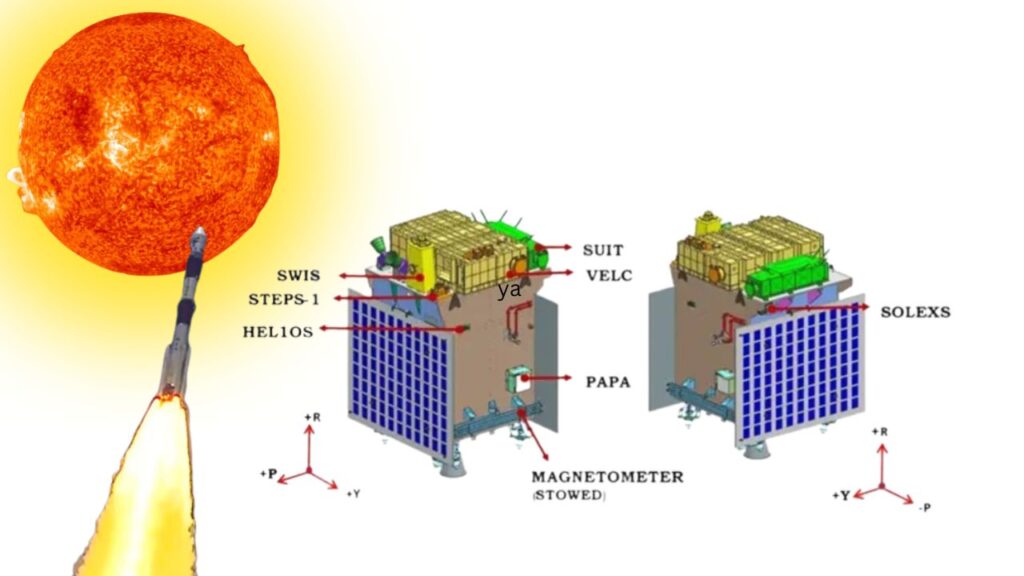Explore India’s groundbreaking Aditya-L1 mission, studying the Sun from a unique vantage point. Learn about its objectives, payloads, and scientific goals.
September 04, 2023: The second Earth-bound maneuver (EBN#2) was successfully performed, resulting in a new orbit of 282 kilometers by 40,225 kilometers.
September 03, 2023: Aditya-L1’s Healthy Status and Upcoming Maneuver
- Just one day after launch, Aditya-L1 remains in excellent health and is operating nominally.
- ISRO announces an upcoming critical maneuver, EBN#2, scheduled for September 5, 2023, around 03:00 Hrs. IST.
- EBN#2 is a pivotal step in Aditya-L1’s journey towards the Sun-Earth L1 point, requiring meticulous planning and execution.
As Aditya-L1 progresses, it inches closer to its vantage point, promising uninterrupted solar observations and valuable insights into solar dynamics and space weather. The mission holds immense potential for expanding our understanding of the Sun and its influence on our solar system. The scientific community eagerly anticipates the wealth of data and discoveries this mission will bring.
September 02, 2023: India’s First Solar Observatory Takes Flight
- India’s first solar observatory, Aditya-L1, commences its journey towards the Sun-Earth L1 point.
- The launch is executed successfully by the reliable PSLV-C57 rocket.
- The satellite is precisely placed in its intended orbit, marking a momentous achievement for the Indian Space Research Organization (ISRO).
Aditya-L1: India’s Solar Observatory Mission
India has embarked on an extraordinary journey into the realm of solar observation with its Aditya-L1 mission. This pioneering endeavor marks India’s first space-based mission to study the Sun in-depth. Positioned in a halo orbit around the Lagrange point 1 (L1) of the Sun-Earth system, approximately 1.5 million kilometers from Earth, Aditya-L1 boasts several advantages, including continuous, unobstructed views of the Sun and real-time observations of solar activities and their impact on space weather.
Key Mission Details
- Launch Success: The Aditya-L1 mission was launched successfully by PSLV-C57, marking a crucial milestone in India’s space exploration endeavors.
- Orbit: The satellite has been precisely placed into its intended orbit, enabling it to fulfill its scientific objectives effectively. The current orbit measures 245 km x 22,459 km.
- Upcoming Maneuver: The next significant maneuver (EBN#2) is scheduled for September 5, 2023, around 03:00 Hrs. IST.

Scientific Objectives
The Aditya-L1 mission carries seven cutting-edge payloads designed to observe various aspects of the Sun, from the photosphere and chromosphere to the outermost layers, the corona. These payloads utilize electromagnetic and particle and magnetic field detectors to gather critical data for scientific research.
Table: Aditya-L1 Payloads and Capabilities
| Type | Payload | Capability |
|---|---|---|
| Remote Sensing Payloads | Visible Emission Line Coronagraph (VELC) | Corona Imaging & Spectroscopy |
| Solar Ultraviolet Imaging Telescope (SUIT) | Photosphere and Chromosphere Imaging – Narrow & Broadband | |
| Solar Low Energy X-ray Spectrometer (SoLEXS) | Soft X-ray spectrometer: Sun-as-a-star observation | |
| High Energy L1 Orbiting X-ray Spectrometer (HEL1OS) | Hard X-ray spectrometer: Sun-as-a-star observation | |
| In-situ Payloads | Aditya Solar wind Particle Experiment (ASPEX) | Solar wind/Particle Analyzer Protons & Heavier Ions with directions |
| Plasma Analyser Package For Aditya (PAPA) | Solar wind/Particle Analyzer Electrons & Heavier Ions with directions |
Science Objectives
The Aditya-L1 mission aims to address various critical science objectives, including:
- Studying Solar Upper Atmospheric Dynamics, including the chromosphere and corona.
- Investigating chromospheric and coronal heating, the physics of partially ionized plasma, and the initiation of coronal mass ejections and flares.
- Observing in-situ particle and plasma environments to understand particle dynamics from the Sun.
- Exploring the physics of the solar corona and its heating mechanisms.
- Diagnosing the plasma within coronal loops, including temperature, velocity, and density measurements.
- Investigating the development, dynamics, and origin of Coronal Mass Ejections (CMEs).
- Studying the magnetic field topology and measurements in the solar corona.
- Identifying drivers for space weather, including the origin, composition, and dynamics of the solar wind.
With its cutting-edge payloads and ambitious scientific goals, Aditya-L1 promises to advance our understanding of the Sun and its impact on our solar system’s space weather. As the mission progresses, scientists and space enthusiasts alike eagerly anticipate the groundbreaking discoveries it may uncover.
Read More: SpaceX Postpones 1st Launch Attempt of Giant New Rocket Due to Technical Issue.
Web Stories from Wisdom Imbibe:






